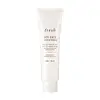What's inside
What's inside
 Key Ingredients
Key Ingredients

 Benefits
Benefits

 Concerns
Concerns

 Ingredients Side-by-side
Ingredients Side-by-side

Water
Skin ConditioningCoco-Glucoside
CleansingButylene Glycol
HumectantGlycerin
HumectantPropanediol
SolventXanthan Gum
Emulsifying1,2-Hexanediol
Skin ConditioningPolyglyceryl-10 Laurate
Skin ConditioningCentaurea Cyanus Flower Water
Skin ConditioningCucumis Sativus Fruit Extract
EmollientHelianthus Annuus Seed Oil
EmollientBorago Officinalis Seed Oil
EmollientHydrolyzed Soy Protein
HumectantRosa Damascena Extract
MaskingRosa Damascena Flower Water
MaskingAloe Barbadensis Leaf Juice
Skin ConditioningPanax Ginseng Root Extract
EmollientMalva Sylvestris Flower Extract
Skin ConditioningRosa Damascena Flower Oil
MaskingTocopherol
AntioxidantCaprylic/Capric Triglyceride
MaskingCaprylyl Glycol
EmollientHydrolyzed Jojoba Esters
Skin ConditioningSilica
AbrasiveCitric Acid
BufferingPentylene Glycol
Skin ConditioningCaramel
Cosmetic ColorantSodium Hydroxide
BufferingSodium Benzoate
MaskingPotassium Sorbate
PreservativeWater, Coco-Glucoside, Butylene Glycol, Glycerin, Propanediol, Xanthan Gum, 1,2-Hexanediol, Polyglyceryl-10 Laurate, Centaurea Cyanus Flower Water, Cucumis Sativus Fruit Extract, Helianthus Annuus Seed Oil, Borago Officinalis Seed Oil, Hydrolyzed Soy Protein, Rosa Damascena Extract, Rosa Damascena Flower Water, Aloe Barbadensis Leaf Juice, Panax Ginseng Root Extract, Malva Sylvestris Flower Extract, Rosa Damascena Flower Oil, Tocopherol, Caprylic/Capric Triglyceride, Caprylyl Glycol, Hydrolyzed Jojoba Esters, Silica, Citric Acid, Pentylene Glycol, Caramel, Sodium Hydroxide, Sodium Benzoate, Potassium Sorbate
Water
Skin ConditioningSorbitol
HumectantGlycerin
HumectantMyristic Acid
CleansingLaureth-4 Carboxylic Acid
Lauryl Hydroxysultaine
CleansingPotassium Hydroxide
BufferingLaureth-6 Carboxylic Acid
CleansingLauric Acid
CleansingEthylhexylglycerin
Skin ConditioningAcrylates/C10-30 Alkyl Acrylate Crosspolymer
Emulsion StabilisingPolyquaternium-7
Palmitic Acid
EmollientGlyceryl Stearate
EmollientParfum
MaskingPhenoxyethanol
PreservativePEG-100 Stearate
Disodium EDTA
PEG-6
HumectantPolyquaternium-39
Dipentaerythrityl Tri-Polyhydroxystearate
EmollientSodium Benzoate
MaskingAluminum Hydroxide
EmollientPEG-65m
Emulsion StabilisingBHT
AntioxidantCitronellol
PerfumingGeraniol
PerfumingWater, Sorbitol, Glycerin, Myristic Acid, Laureth-4 Carboxylic Acid, Lauryl Hydroxysultaine, Potassium Hydroxide, Laureth-6 Carboxylic Acid, Lauric Acid, Ethylhexylglycerin, Acrylates/C10-30 Alkyl Acrylate Crosspolymer, Polyquaternium-7, Palmitic Acid, Glyceryl Stearate, Parfum, Phenoxyethanol, PEG-100 Stearate, Disodium EDTA, PEG-6, Polyquaternium-39, Dipentaerythrityl Tri-Polyhydroxystearate, Sodium Benzoate, Aluminum Hydroxide, PEG-65m, BHT, Citronellol, Geraniol
 Reviews
Reviews

Ingredients Explained
These ingredients are found in both products.
Ingredients higher up in an ingredient list are typically present in a larger amount.
Glycerin is already naturally found in your skin. It helps moisturize and protect your skin.
A study from 2016 found glycerin to be more effective as a humectant than AHAs and hyaluronic acid.
As a humectant, it helps the skin stay hydrated by pulling moisture to your skin. The low molecular weight of glycerin allows it to pull moisture into the deeper layers of your skin.
Hydrated skin improves your skin barrier; Your skin barrier helps protect against irritants and bacteria.
Glycerin has also been found to have antimicrobial and antiviral properties. Due to these properties, glycerin is often used in wound and burn treatments.
In cosmetics, glycerin is usually derived from plants such as soybean or palm. However, it can also be sourced from animals, such as tallow or animal fat.
This ingredient is organic, colorless, odorless, and non-toxic.
Glycerin is the name for this ingredient in American English. British English uses Glycerol/Glycerine.
Learn more about GlycerinSodium Benzoate is a preservative. It's used in both cosmetic and food products to inhibit the growth of mold and bacteria. It is typically produced synthetically.
Both the US FDA and EU Health Committee have approved the use of sodium benzoate. In the US, levels of 0.1% (of the total product) are allowed.
Sodium benzoate works as a preservative by inhibiting the growth of bacteria inside of cells. It prevents the cell from fermenting a type of sugar using an enzyme called phosphofructokinase.
It is the salt of benzoic acid. Foods containing sodium benzoate include soda, salad dressings, condiments, fruit juices, wines, and snack foods.
Studies for using ascorbic acid and sodium benzoate in cosmetics are lacking, especially in skincare routines with multiple steps.
We always recommend speaking with a professional, such as a dermatologist, if you have any concerns.
Learn more about Sodium BenzoateWater. It's the most common cosmetic ingredient of all. You'll usually see it at the top of ingredient lists, meaning that it makes up the largest part of the product.
So why is it so popular? Water most often acts as a solvent - this means that it helps dissolve other ingredients into the formulation.
You'll also recognize water as that liquid we all need to stay alive. If you see this, drink a glass of water. Stay hydrated!
Learn more about Water